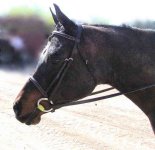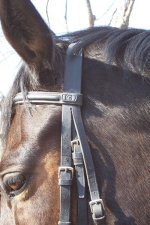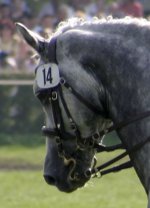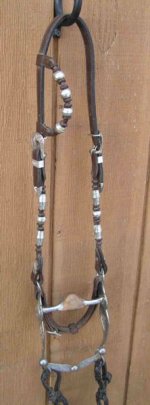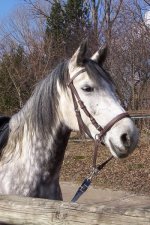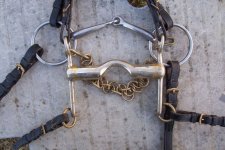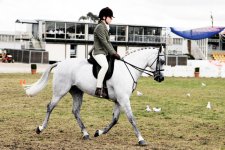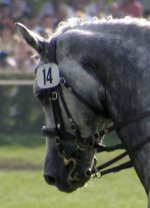♘امیرحسین♞
♘ مدیریت انجمن اسب ایران ♞
A bridle is a piece of equipment used to control a horse. The bridle fits over a horse's head, and has the purpose of controlling the horse. It holds a bit in the horse's mouth, or holds on the nosepiece of a hackamore and other type of bitless bridle.
Parts of the Bridle
The bridle is also referred to as a headstall and consists of the following elements:
* Crownpiece: The crownpiece or crown (headpiece - UK) goes over the horse's head and rests just behind the animal's ears. It is the main strap that holds the bridle in place and prevents the bit from slipping down.
* Cheekpieces: Two cheekpieces attach to either side of the crownpiece and run down the side of the horse's face, along the cheek. They attach to the bit rings. In a double bridle, two pairs of cheekpieces are used.
* Throatlatch: the throatlatch or throatlash (UK) is usually part of the same piece of leather as the crownpiece. It runs from the horse's right ear, under his throatlatch or windpipe area, and attaches below the left ear. The main purpose of the throatlatch is to prevent the bridle from coming off over the horse's head. However, given that horses should not be tied or allowed to rub their heads on objects, the throatlatch is relatively unimportant. It is important, when bridling a horse, not to tighten the throatlatch too much, as it will place pressure on the animal's windpipe and constrict its breathing.
* Browband: The crownpiece actually runs through the browband. The browband runs from just under one ear of the horse, across his forehead, to just under the other ear. In certain sports, such as dressage and Saddle seat, decorative browbands are sometimes fashionable.
* Noseband: the noseband encircles the nose of the horse. It is often used to keep the animal's mouth closed, or to attach other pieces or equipment, such as martingales.
* Cavesson is a specific type of noseband used on English bridles wherein the noseband is attached to its own headstall, held onto the rest of the bridle by the browband. A cavesson can be adjusted with greater precision than a noseband that is simply attached to the same cheekpieces that hold the bit. In Saddle seat riding, the cavesson is often brightly colored and matches the browband.
* Reins: The reins of a bridle attach to the bit, below the attachment for the cheekpieces. The reins are the rider's link to the horse, and are seen on every bridle. Reins are often laced, braided, have stops, or are made of rubber or some other tacky material to provide extra grip.
* Bit: The bit goes into the horse's mouth, resting on the sensitive interdental space between the horse's teeth known as the "bars."
Types of Bridles
* Snaffle bridle: the "English-type" snaffle bridle is most commonly seen in English riding. It is a basic bridle that carries one bit and usually has one set of reins. Despite the name, a snaffle bridle may be used not only with a snaffle bit, but also with almost other types of single rein bits, including kimberwickes, gag bits, and single curb bits. The English bridle is almost always used with some type of cavesson noseband.
* Pelham bridle: The Pelham is another English type bridle that carries a single bit, in this case a Pelham bit, but one that requires two sets of reins, one for snaffle pressure and one for curb pressure.
* Western bridle: used for western riding, this bridle usually does not have a noseband. Many western bridles also lack browbands, sometimes replaced by a "split ear" design where a small strap encircles one or both ears to provide extra security to keep the bridle on.
* Double bridles: Also called a Weymouth bridle, double bridles use two bits at once, a small snaffle called a bradoon and a curb or Weymouth bit, and require the use of two sets of reins. Double bridles are usually only seen used in upper level dressage, in Saddle seat riding, and for showing in certain other events that require the most formal attire and equipment.
Hackamores and other bitless bridles
A hackamore, put simply, is a bridle that has a nosepiece for control instead of a bit. A hackamore is not the same thing as a halter, as a halter is only effective for a person controlling a horse from the ground, not in the saddle. A "bitless bridle" is similar to a hackamore, but uses slightly different leverage principles. Hackamores and bitless bridles use a bridle headstall, with reins attached to some type of noseband or nosepiece and operates in a manner similar to a bridle, though without a bit mouthpiece. Various designs allow control and good communication to the horse and may, in come cases, be more comfortable to the horse, particularly a young animal or one with a mouth injury.
The jaquima or original bosal style hackamores is mostly seen on young horses being started under saddle in western riding disciplines. Bitless bridles and other types of hackamore are most often seen on horses used for endurance riding and trail riding. Sometimes they are seen at rodeos. Most horse show events do not allow bitless bridles of any kind. The exceptions are show jumping, where equipment rules are fairly generous, and in certain western horse show classes for "junior" horses, which do not allow "bitless bridles" but do permit the bosal hackamore.
Besides the bosal hackamore, there are many different designs. English riders sometimes use a jumping cavesson which is basically a leather noseband reinforced internally with a cable, with bridle rings attached. Another popular bitless design uses technology the primarily puts pressure on the poll of the horse. Other designs that combine elements of the bosal hackamore and the bitless bridle are known as sidepulls, act mostly on the nose, and are popular with western riders. Arguably, the so-called mechanical hackamore, essentially a noseband on shanks that puts considerable leverage on the jaw and poll, could also be considered a type of bitless birdle that uses curb leverage on the nose and jaw rather than the mouth.
Some riders, not realizing that a horse's head overall is a very sensitive area, use a hackamore or bitless bridle without the same caution they might use with a bit, thus defeating any benefit that an apparently milder form of gear would otherwise provide. While many bitless designs are marketed as "humane," and some are indeed quite mild, other designs can be remarkably harsh, particularly if they are improperly adjusted or have metal parts, a thin design, or rough surfaces.
Fitting a bridle
Also see bit and noseband for more information on fitting the bridle.
Without properly fitting the bridle to the horses’ head, the horse may be uncomfortable, and poor fitting may also result in lack of control while riding or unclear communication.
In order to effectively and safely use a bridle, the length of each piece of the bridle needs to be individually adjusted to fit the horse's head. The width of the bit needs to be adjusted to the width of the horse's mouth so it is not too wide nor too narrow. When fitting the cheekpieces, their length should be adjusted so that the bit is held neither too high nor too low in the horse's mouth, to ensure good communication between horse and rider. The adjustment of the noseband varies, depending on the type used. However, it is most often adjusted so that one finger can fit between the noseband and the horse. The browband should not rub or pinch the horse's ears, and also should not pull the bridle forward so that it rubs on the back of the ears. When tightening the throatlatch, the width of four fingers should be able to fit between the throatlatch and the horses’ cheek.
Dangers of tying with a bridle
Despite what is commonly seen in movies, a horse should never be tied with the reins of a bridle to a solid object, as it could pull back and not only break the reins or bridle, but also severely injure its mouth, tongue, jaw or neck. This is also true for cross-tying a horse. Should a rider need to tie a horse, it is best to either remove the bridle and put on a halter, or to put a halter on in addition to the bridle (under or over the bridle), but in either case, tie the horse using the halter only.
In western riding, some horses are taught to "ground tie" with a bridle, that is, to stand still when the reins are dropped on the ground. This can only be done with split reins, as a horse can easily put a foot through a pair of reins that are attached to one another. Even with split reins, a horse can still step on a rein, jerk its head up and both break the rein and injure its mouth. Thus, ground tying is not generally advised, even with a horse trained to do so. Historically, it was a useful skill if a rider had to momentarily dismount and perform a task that required both hands (such as removing brush or fixing a fence) in a remote area where tying was impracticable. In actual practice, just as with the "stay" command used in obedience work for dogs, even well-trained horses will not stay "ground tied" for long, especially if left unsupervised. They will soon begin grazing or become restless and often will wander off. Thus, ground tying today is usually seen in specific classes at horse shows such as the trail horse class, or as a useful short-term command: many horses are taught to stand still for a limited period of time on a "whoa" or "stay" command, with or without dropping the reins.
Parts of the Bridle
The bridle is also referred to as a headstall and consists of the following elements:
* Crownpiece: The crownpiece or crown (headpiece - UK) goes over the horse's head and rests just behind the animal's ears. It is the main strap that holds the bridle in place and prevents the bit from slipping down.
* Cheekpieces: Two cheekpieces attach to either side of the crownpiece and run down the side of the horse's face, along the cheek. They attach to the bit rings. In a double bridle, two pairs of cheekpieces are used.
* Throatlatch: the throatlatch or throatlash (UK) is usually part of the same piece of leather as the crownpiece. It runs from the horse's right ear, under his throatlatch or windpipe area, and attaches below the left ear. The main purpose of the throatlatch is to prevent the bridle from coming off over the horse's head. However, given that horses should not be tied or allowed to rub their heads on objects, the throatlatch is relatively unimportant. It is important, when bridling a horse, not to tighten the throatlatch too much, as it will place pressure on the animal's windpipe and constrict its breathing.
* Browband: The crownpiece actually runs through the browband. The browband runs from just under one ear of the horse, across his forehead, to just under the other ear. In certain sports, such as dressage and Saddle seat, decorative browbands are sometimes fashionable.
* Noseband: the noseband encircles the nose of the horse. It is often used to keep the animal's mouth closed, or to attach other pieces or equipment, such as martingales.
* Cavesson is a specific type of noseband used on English bridles wherein the noseband is attached to its own headstall, held onto the rest of the bridle by the browband. A cavesson can be adjusted with greater precision than a noseband that is simply attached to the same cheekpieces that hold the bit. In Saddle seat riding, the cavesson is often brightly colored and matches the browband.
* Reins: The reins of a bridle attach to the bit, below the attachment for the cheekpieces. The reins are the rider's link to the horse, and are seen on every bridle. Reins are often laced, braided, have stops, or are made of rubber or some other tacky material to provide extra grip.
* Bit: The bit goes into the horse's mouth, resting on the sensitive interdental space between the horse's teeth known as the "bars."
Types of Bridles
* Snaffle bridle: the "English-type" snaffle bridle is most commonly seen in English riding. It is a basic bridle that carries one bit and usually has one set of reins. Despite the name, a snaffle bridle may be used not only with a snaffle bit, but also with almost other types of single rein bits, including kimberwickes, gag bits, and single curb bits. The English bridle is almost always used with some type of cavesson noseband.
* Pelham bridle: The Pelham is another English type bridle that carries a single bit, in this case a Pelham bit, but one that requires two sets of reins, one for snaffle pressure and one for curb pressure.
* Western bridle: used for western riding, this bridle usually does not have a noseband. Many western bridles also lack browbands, sometimes replaced by a "split ear" design where a small strap encircles one or both ears to provide extra security to keep the bridle on.
* Double bridles: Also called a Weymouth bridle, double bridles use two bits at once, a small snaffle called a bradoon and a curb or Weymouth bit, and require the use of two sets of reins. Double bridles are usually only seen used in upper level dressage, in Saddle seat riding, and for showing in certain other events that require the most formal attire and equipment.
Hackamores and other bitless bridles
A hackamore, put simply, is a bridle that has a nosepiece for control instead of a bit. A hackamore is not the same thing as a halter, as a halter is only effective for a person controlling a horse from the ground, not in the saddle. A "bitless bridle" is similar to a hackamore, but uses slightly different leverage principles. Hackamores and bitless bridles use a bridle headstall, with reins attached to some type of noseband or nosepiece and operates in a manner similar to a bridle, though without a bit mouthpiece. Various designs allow control and good communication to the horse and may, in come cases, be more comfortable to the horse, particularly a young animal or one with a mouth injury.
The jaquima or original bosal style hackamores is mostly seen on young horses being started under saddle in western riding disciplines. Bitless bridles and other types of hackamore are most often seen on horses used for endurance riding and trail riding. Sometimes they are seen at rodeos. Most horse show events do not allow bitless bridles of any kind. The exceptions are show jumping, where equipment rules are fairly generous, and in certain western horse show classes for "junior" horses, which do not allow "bitless bridles" but do permit the bosal hackamore.
Besides the bosal hackamore, there are many different designs. English riders sometimes use a jumping cavesson which is basically a leather noseband reinforced internally with a cable, with bridle rings attached. Another popular bitless design uses technology the primarily puts pressure on the poll of the horse. Other designs that combine elements of the bosal hackamore and the bitless bridle are known as sidepulls, act mostly on the nose, and are popular with western riders. Arguably, the so-called mechanical hackamore, essentially a noseband on shanks that puts considerable leverage on the jaw and poll, could also be considered a type of bitless birdle that uses curb leverage on the nose and jaw rather than the mouth.
Some riders, not realizing that a horse's head overall is a very sensitive area, use a hackamore or bitless bridle without the same caution they might use with a bit, thus defeating any benefit that an apparently milder form of gear would otherwise provide. While many bitless designs are marketed as "humane," and some are indeed quite mild, other designs can be remarkably harsh, particularly if they are improperly adjusted or have metal parts, a thin design, or rough surfaces.
Fitting a bridle
Also see bit and noseband for more information on fitting the bridle.
Without properly fitting the bridle to the horses’ head, the horse may be uncomfortable, and poor fitting may also result in lack of control while riding or unclear communication.
In order to effectively and safely use a bridle, the length of each piece of the bridle needs to be individually adjusted to fit the horse's head. The width of the bit needs to be adjusted to the width of the horse's mouth so it is not too wide nor too narrow. When fitting the cheekpieces, their length should be adjusted so that the bit is held neither too high nor too low in the horse's mouth, to ensure good communication between horse and rider. The adjustment of the noseband varies, depending on the type used. However, it is most often adjusted so that one finger can fit between the noseband and the horse. The browband should not rub or pinch the horse's ears, and also should not pull the bridle forward so that it rubs on the back of the ears. When tightening the throatlatch, the width of four fingers should be able to fit between the throatlatch and the horses’ cheek.
Dangers of tying with a bridle
Despite what is commonly seen in movies, a horse should never be tied with the reins of a bridle to a solid object, as it could pull back and not only break the reins or bridle, but also severely injure its mouth, tongue, jaw or neck. This is also true for cross-tying a horse. Should a rider need to tie a horse, it is best to either remove the bridle and put on a halter, or to put a halter on in addition to the bridle (under or over the bridle), but in either case, tie the horse using the halter only.
In western riding, some horses are taught to "ground tie" with a bridle, that is, to stand still when the reins are dropped on the ground. This can only be done with split reins, as a horse can easily put a foot through a pair of reins that are attached to one another. Even with split reins, a horse can still step on a rein, jerk its head up and both break the rein and injure its mouth. Thus, ground tying is not generally advised, even with a horse trained to do so. Historically, it was a useful skill if a rider had to momentarily dismount and perform a task that required both hands (such as removing brush or fixing a fence) in a remote area where tying was impracticable. In actual practice, just as with the "stay" command used in obedience work for dogs, even well-trained horses will not stay "ground tied" for long, especially if left unsupervised. They will soon begin grazing or become restless and often will wander off. Thus, ground tying today is usually seen in specific classes at horse shows such as the trail horse class, or as a useful short-term command: many horses are taught to stand still for a limited period of time on a "whoa" or "stay" command, with or without dropping the reins.

